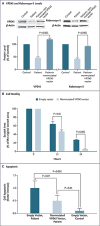A congenital neutrophil defect syndrome associated with mutations in VPS45
- PMID: 23738510
- PMCID: PMC3787600
- DOI: 10.1056/NEJMoa1301296
A congenital neutrophil defect syndrome associated with mutations in VPS45
Abstract
Background: Neutrophils are the predominant phagocytes that provide protection against bacterial and fungal infections. Genetically determined neutrophil disorders confer a predisposition to severe infections and reveal novel mechanisms that control vesicular trafficking, hematopoiesis, and innate immunity.
Methods: We clinically evaluated seven children from five families who had neutropenia, neutrophil dysfunction, bone marrow fibrosis, and nephromegaly. To identify the causative gene, we performed homozygosity mapping using single-nucleotide polymorphism arrays, whole-exome sequencing, immunoblotting, immunofluorescence, electron microscopy, a real-time quantitative polymerase-chain-reaction assay, immunohistochemistry, flow cytometry, fibroblast motility assays, measurements of apoptosis, and zebrafish models. Correction experiments were performed by transfecting mutant fibroblasts with the nonmutated gene.
Results: All seven affected children had homozygous mutations (Thr224Asn or Glu238Lys, depending on the child's ethnic origin) in VPS45, which encodes a protein that regulates membrane trafficking through the endosomal system. The level of VPS45 protein was reduced, as were the VPS45 binding partners rabenosyn-5 and syntaxin-16. The level of β1 integrin was reduced on the surface of VPS45-deficient neutrophils and fibroblasts. VPS45-deficient fibroblasts were characterized by impaired motility and increased apoptosis. A zebrafish model of vps45 deficiency showed a marked paucity of myeloperoxidase-positive cells (i.e., neutrophils). Transfection of patient cells with nonmutated VPS45 corrected the migration defect and decreased apoptosis.
Conclusions: Defective endosomal intracellular protein trafficking due to biallelic mutations in VPS45 underlies a new immunodeficiency syndrome involving impaired neutrophil function. (Funded by the National Human Genome Research Institute and others.).
Figures




References
-
- Malech HL, Gallin JI. Immunology: neutrophils in human diseases. N Engl J Med. 1987;317:687–94. - PubMed
-
- Klein C. Congenital neutropenia. Hematol Oncol Clin North Am. 2013;27(3):xi–xii. - PubMed
-
- Klein C. Genetic defects in severe congenital neutropenia: emerging insights into life and death of human neutrophil granulocytes. Annu Rev Immunol. 2011;29:399–413. - PubMed
-
- Dell'Angelica EC, Shotelersuk V, Aguilar RC, Gahl WA, Bonifacino JS. Altered trafficking of lysosomal proteins in Hermansky-Pudlak syndrome due to mutations in the beta 3A subunit of the AP-3 adaptor. Mol Cell. 1999;3:11–21. - PubMed
-
- Bohn G, Allroth A, Brandes G, et al. A novel human primary immunodeficiency syndrome caused by deficiency of the endosomal adaptor protein p14. Nat Med. 2007;13:38–45. - PubMed
Publication types
MeSH terms
Substances
Grants and funding
LinkOut - more resources
Full Text Sources
Other Literature Sources
Molecular Biology Databases
Research Materials
